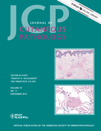Ultrastructural and molecular confirmation of the trichodysplasia spinulosa-associated polyomavirus in biopsies of patients with trichodysplasia spinulosa
Abstract
Trichodysplasia spinulosa (TS) is a rare and only recently characterized cutaneous disease occurring in immunocompromised patients. The disease is characterized by spiny follicular papules on clinical examination and by the presence of viral inclusions at ultrastructural examination. In the last year, this virus has been identified as a new member of the polyomavirus family and designated as TS-associated polyomavirus (TSPyV). We report two organ transplant patients with this disease in which we were able to identify the TSPyV at ultrastructural and molecular level from formalin-fixed paraffin-embedded biopsies of lesional skin. Similar to prior described cases, the patients presented with follicular papules which were concentrated on the central face and associated with alopecia. Histopathology of both cases showed dilated follicular infundibula plugged with cornified eosinophilic cells containing large trichohyaline granules. Transmission electron microscopy on paraffin-embedded tissue in case 1 showed 28-nm intracellular viral particles morphologically consistent with polyoma virus. For both cases the presence of TSPyV was confirmed by polymerase chain reaction with virus-specific primers followed by identification by direct sequencing. These two cases show the presence of the newly described TSPyV in TS further establishing its association with this distinctive disease.




